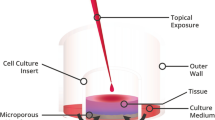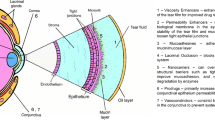Abstract
The objective of this study was to compare the influence of pH, tonicity, benzalkonium chloride, and EDTA on the conjunctival and corneal penetration of four beta blockers—atenolol, timolol, levobunolol, and betaxolol. Drug penetration was evaluated using the isolated pigmented rabbit conjunctiva and cornea in the modified Ussing chamber. The conjunctiva was more permeable than the cornea to all four beta blockers. Formulation changes caused larger changes in corneal than in conjunctival drug penetration, especially for the hydrophilic beta blockers, atenolol and timolol. Raising the solution pH to 8.4 caused the largest increase in corneal penetration for all drugs except atenolol. This increase was greater than that obtained by removing the corneal epithelium. The same formulation also increased conjunctival drug penetration, although to a lesser extent. In the case of timolol, the formulation changes evaluated brought about similar changes in its ocular and systemic absorption with good in vitro–in vivo correlations. The above findings indicate that in making formulation changes to maximize corneal drug penetration, it is necessary to evaluate possible changes in conjunctival drug penetration, hence systemic absorption. Moreover, because the conjunctiva plays an active role in the noncorneal route of ocular drug absorption, the relative contribution of the noncorneal to the corneal routes to ocular drug absorption may also be altered by formulation changes.
Similar content being viewed by others
REFERENCES
S. C. Chang and V. H. L. Lee. Nasal and conjunctival contributions to the systemic absorption of topical timolol in the pigmented rabbit: Implications in the design of strategies to maximize the ratio of ocular to systemic absorption. J. Ocular Pharmacol. 3:159–169 (1987).
M. A. Walsky, M. M. Jablonski, and H. F. Edelhauser. Comparison of conjunctival and corneal surface areas in rabbit and human. Curr. Eye Res. 7:483–486 (1988).
G. M. Grass, R. W. Wood, and J. R. Robinson. Effects of calcium chelating agents on corneal permeability. Invest. Ophthalmol. Vis. Sci. 26:110–113 (1985).
O. Camber and P. Edman. Influence of some preservatives on the corneal permeability of pilocarpine and dexamethasone, in vitro. Int. J. Pharm. 39:229–234 (1987).
I. Ahmed and B. Chaudh. Evaluation of buffer systems in ophthalmic product development. Int. J. Pharm. 44:97–105 (1988).
S. S. Chrai, T. F. Patton, A. Mehta, and J. R. Robinson. Lacrimal and instilled fluid dynamics and rabbit eyes. J. Pharm. Sci. 62:1112–1121 (1973).
V. H. L. Lee, D. S. Chien, and H. Sasaki. Ocular ketone reductase distribution and its role in the metabolism of ocularly applied levobunolol in the pigmented rabbit. J. Pharmacol. Exp. Ther. 246:871–878 (1988).
H. F. Edelhauser, J. R. Hoffert, and P. O. Fromm. In vitro ion and water movement in corneas of rainbow trout. Invest. Ophthalmol. 4:290–296 (1965).
S. C. Chang, H. Bundgaard, A. Burr, and V. H. L. Lee. Improved corneal penetration of timolol by prodrugs as a means to reduce systemic drug load. Invest. Ophthalmol. Vis. Sci. 28:487–491 (1987).
R. R. Pfister. The normal surface of conjunctiva epithelium. A scanning electron microscopic study. Invest. Ophthalmol. Vis. Sci. 14:267–279 (1975).
B. A. Nichols, M. L. Chiappino, and C. R. Dawson. Demonstration of the mucous layer of the tear film by electron microscopy. Invest. Ophthalmol. Vis. Sci. 26:464–473 (1985).
A. J. W. Huang, R. Belldegrun, L. Hanninen, K. R. Kenyon, S. C. G. Tseng, and M. F. Refojo. Effect of hypertonic solutions on conjunctival epithelium and mucinlike glycoprotein discharge. Cornea 8:15–20 (1989).
M. G. Doane, A. D. Jensen, and C. H. Dohlman. Penetration routes of topically applied eye medications. Am. J. Ophthalmol. 85:383–386 (1978).
J. W. Sieg and J. R. Robinson. Vehicle effects on ocular drug bioavailability. II. Evaluation of pilocarpine. J. Pharm. Sci. 66:1222–1228(1977).
D. M. Maurice. The tonicity of an eye drop and its dilution by tears. Exp. Eye Res. 11:30–33 (1971).
L. S. Liebovitch and S. Weinbaum. A Model of epithelial water transport: The corneal endothelium. Biophys. J. 35:315–338 (1981).
P. Ashton, R. Diepold, A. Plätzer, and V. H. L. Lee. Effect of chlorhexidine acetate on the corneal penetration of sorbitol from an arnolol formulation in the pigmented rabbit. J. Ocul. Pharmacol. 6:37–42 (1990).
R. L. Shih and V. H. L. Lee. Rate limiting barrier to the penetration of ocular hypotensive beta blockers across the corneal epithelium in the pigmented rabbit. J. Ocul. Pharmacol. 6:329–336 (1990).
Author information
Authors and Affiliations
Rights and permissions
About this article
Cite this article
Ashton, P., Podder, S.K. & Lee, V.H.L. Formulation Influence on Conjunctival Penetration of Four Beta Blockers in the Pigmented Rabbit: A Comparison with Corneal Penetration. Pharm Res 8, 1166–1174 (1991). https://doi.org/10.1023/A:1015810619869
Issue Date:
DOI: https://doi.org/10.1023/A:1015810619869




